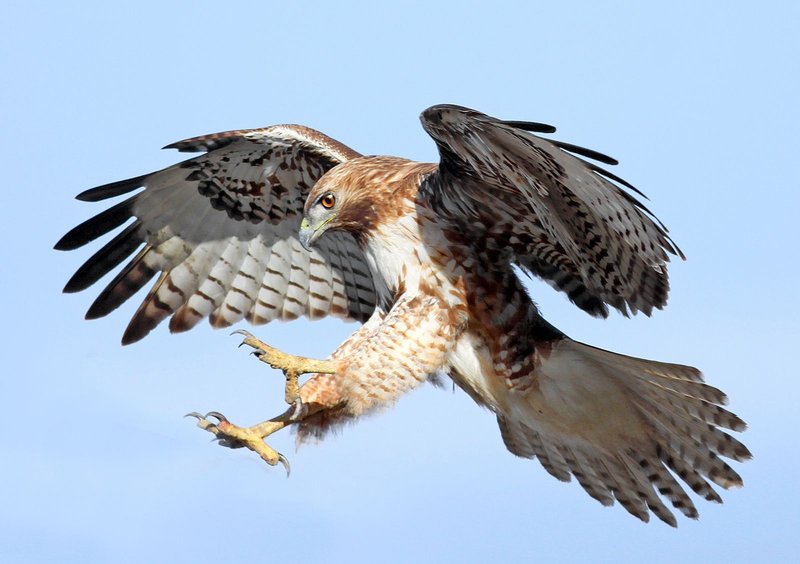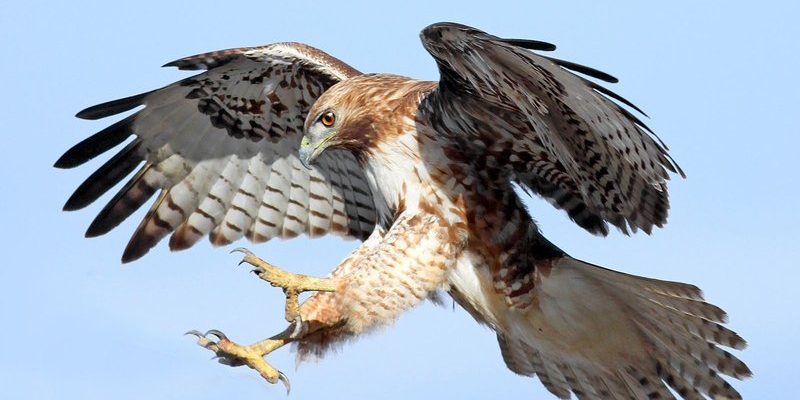
Imagine standing on a mountain peak, feeling the cool breeze on your face, and watching as a magnificent bird soars effortlessly across the sky. That bird is likely a hawk, one of nature’s most skilled and beautiful hunters. Hawks are part of the family Accipitridae and are known for their sharp vision and powerful wings. These birds of prey come in various species, each with unique traits, but they all share some impressive characteristics, making them fascinating creatures to observe.
Hawks have a long-standing place in human culture and history. They symbolize strength, freedom, and keen insight. From Native American folklore to modern sports teams, the hawk has been celebrated as a powerful and inspiring figure. But beyond the symbolism, hawks play a critical role in our ecosystems. They help control populations of smaller animals, ensuring balance in nature.
If you’ve ever spotted a hawk perched on a tree branch or gliding high above, you might be captivated by its beauty. These birds are not only visually stunning but are also marvels of evolution, equipped with remarkable adaptations that make them efficient hunters. Let’s dive deeper into the world of hawks and explore their habitats, diets, and fascinating behaviors.
Types of Hawks
Hawks come in various shapes and sizes, and categorizing them can be a bit confusing. Generally, we can break them down into two main groups: buteos and accipiters. Buteos are broad-winged and have a relatively large body, often seen soaring gracefully in the sky. On the other hand, accipiters are more agile and have shorter, rounded wings, designed for quick, darting movements through trees.
Some well-known species of hawks include the Red-tailed Hawk, which is easily recognizable by its reddish tail and strong, soaring flight. Another popular species is the Cooper’s Hawk, which is known for its ability to navigate through dense forests while hunting smaller birds. Each of these species has adapted well to their environments, showcasing the versatility of the hawk family.
When identifying hawks, you’ll notice differences in their plumage, size, and behavior. For instance, the Sharp-shinned Hawk is smaller than many other hawks, often preying on songbirds. In contrast, the Ferruginous Hawk, found in open grasslands, has a larger frame and hunts small mammals. This diversity not only makes hawks interesting to watch but also helps them thrive in various habitats around the world.
Habitat and Range
Hawks are incredibly adaptable birds, and their habitats vary widely depending on the species. They thrive in a range of environments, including forests, grasslands, deserts, and even urban areas. You might spot them perched on power lines, soaring over open fields, or nesting in tall trees. This adaptability helps them find food and raise their young in different landscapes.
Some hawk species prefer open spaces where they can hunt small mammals like rabbits and field mice, while others favor wooded areas for hunting birds and squirrels. For example, the Red-tailed Hawk is often seen soaring above fields and forests in North America, while the Common Buzzard can be found in various habitats across Europe and Asia.
Interestingly, hawks migrate seasonally, traveling long distances to find suitable nesting and feeding grounds. For instance, the Swainson’s Hawk migrates from North America to Argentina, covering thousands of miles. These migratory patterns highlight their resilience and ability to adapt to changing environments throughout the year.
Diet and Hunting Techniques
Hawks are carnivorous and have a diet primarily consisting of small mammals, birds, reptiles, and insects. Their exceptional vision plays a crucial role in hunting, allowing them to spot prey from great heights. Imagine having the ability to see a mouse scurrying through the grass from a mile up in the sky—that’s the superpower of a hawk!
When hunting, hawks employ a variety of techniques depending on their species. Some, like the Red-tailed Hawk, prefer to soar high in the sky, scanning the ground for movement. Once they spot their target, they dive down with incredible speed, using their sharp talons to grasp the prey tightly. Others, like the Coopers Hawk, excel in stealth and agility. They often fly low and fast through trees to surprise unsuspecting birds.
Hawks also have unique ways of hunting based on their surroundings. In open fields, they may practice a technique called perch hunting, where they sit silently on a high vantage point, waiting for the right moment to strike. In forested areas, they might use their quick reflexes to maneuver through branches, catching their prey off guard. This versatility in hunting methods showcases their evolutionary adaptations and mastery as predators.
Reproduction and Lifecycle
Hawks have fascinating reproductive behaviors, typically mating for life. These birds are very selective when it comes to choosing their partners, often engaging in elaborate courtship displays that include aerial acrobatics and vocalizations. Once they find a mate, they establish territories where they will raise their young.
Nesting usually takes place in tall trees or cliffs, where they can create a safe environment for eggs. The female hawk lays anywhere from 1 to 5 eggs, depending on the species. Interestingly, both parents share responsibilities in raising the chicks, with the male often hunting to provide food while the female stays at the nest.
After hatching, the chicks are altricial, meaning they are born helpless and require a lot of care. They grow quickly, developing feathers and strength in just a few weeks. By the time they reach about 6 to 8 weeks, they are ready to leave the nest and start exploring the world on their own. This stage of life is critical, as young hawks learn to hunt and navigate their surroundings, ensuring their survival in the wild.
Conservation Status
The conservation status of hawks varies greatly depending on the species. While many hawk populations are stable or even thriving, some are facing significant threats from habitat loss, hunting, and environmental pollution. For instance, the Northern Goshawk, often found in forested regions, has seen its habitat diminish due to logging and land development.
Conservation efforts are crucial to protect these majestic birds and their habitats. Organizations and wildlife agencies work tirelessly to create protected areas, promote public awareness, and implement regulations to prevent illegal hunting. These initiatives aim to ensure that future generations can enjoy watching hawks soar through the skies.
As a nature enthusiast, you can contribute to these efforts by supporting conservation groups, participating in local wildlife monitoring programs, and respecting hawk habitats. Every small action can make a big difference in preserving the beauty of our natural world.
Fascinating Facts About Hawks
| Fact | Description |
|---|---|
| Vision | Hawks have incredibly sharp eyesight, estimated to be 8 times better than humans, allowing them to spot prey from a great distance. |
| Speed | Some hawks can reach speeds of over 120 miles per hour during their hunting dives! |
| Lifespan | In the wild, hawks can live between 10 to 20 years, depending on the species and environmental conditions. |
| Migration | Many hawks are migratory, traveling thousands of miles to find suitable breeding grounds. |
| Community | Hawks are often seen socializing in groups, especially during migration, which can be a breathtaking sight! |
Hawk Watching: Tips for Enthusiasts
If you’re eager to spot hawks in the wild, there are a few tips that’ll help you become a successful hawk watcher. First, find local parks or nature reserves known for their hawk populations. Early mornings and late afternoons are prime times for seeing these birds, as they’re often most active during these hours.
Use binoculars or a spotting scope to get a better view without disturbing them. When scanning the skies, look for characteristic shapes: broad wings gliding or the silhouette of a hawk perched on a tree. It helps to learn about the specific species found in your area, as this knowledge can make spotting them more exciting.
Don’t forget to bring a notebook or camera to document your observations. Not only will this enhance your experience, but it also allows you to share your encounters with other nature lovers. Hawk-watching can be a fulfilling hobby, connecting you to nature while enjoying the thrill of observing these magnificent birds in action.
FAQ
What are hawks known for?
Hawks are famous for their incredible hunting skills and sharp eyesight. Their ability to spot prey from high altitudes makes them top predators in their habitats. Additionally, they are known for their distinctive flight patterns and powerful wings, which allow them to soar effortlessly.
How do hawks communicate?
Hawks communicate using a variety of vocalizations, including high-pitched calls and screams. These sounds can convey different messages, such as alerting their mate to danger or establishing territory. Body language, like wing flapping or posturing, is also part of hawk communication.
Can hawks be kept as pets?
While some people may consider keeping hawks, it’s important to note that they are wild animals and require specific care that most people cannot provide. In many places, it’s illegal to keep hawks as pets without special permits. Instead, it’s better to enjoy observing them in their natural habitats.
What do baby hawks eat?
Baby hawks, or chicks, rely on their parents for food in the early stages of life. They’re typically fed small mammals, birds, or even insects that their parents catch. As they grow older, they start learning to hunt on their own.
How long does it take for hawks to mature?
Hawks reach maturity at different rates depending on the species. Generally, it takes about 1 to 2 years for a hawk to become fully mature and capable of breeding. During this time, they learn essential survival skills, including hunting and territory establishment.
Are hawks endangered?
The conservation status of hawks varies across different species. While some are thriving, others face threats from habitat loss and environmental pollution. It’s essential to stay informed about local species and their conservation needs to help protect them.
What is the largest hawk species?
The Ferruginous Hawk is often recognized as the largest hawk in North America. It can weigh up to 5.5 pounds and has a wingspan of nearly 5 feet. This species is known for its striking plumage and hunting prowess.
Do hawks play a role in the ecosystem?
Absolutely! Hawks are important members of the ecosystem, helping to control populations of small mammals and birds. By preying on these animals, they maintain balance in their environment, which is crucial for the health of local ecosystems.
How can I help hawks in my area?
You can support hawks by educating yourself and others about their importance, participating in local conservation efforts, and creating habitats in your backyard that attract them. Planting native vegetation and avoiding pesticides can help foster a welcoming environment for these birds.
What should I do if I find an injured hawk?
If you encounter an injured hawk, it’s essential to contact local wildlife authorities or a rehabilitation center specializing in birds of prey. They have the training and resources to help the bird properly. Remember, handling wild animals can be dangerous, so it’s best to leave it to the professionals.

